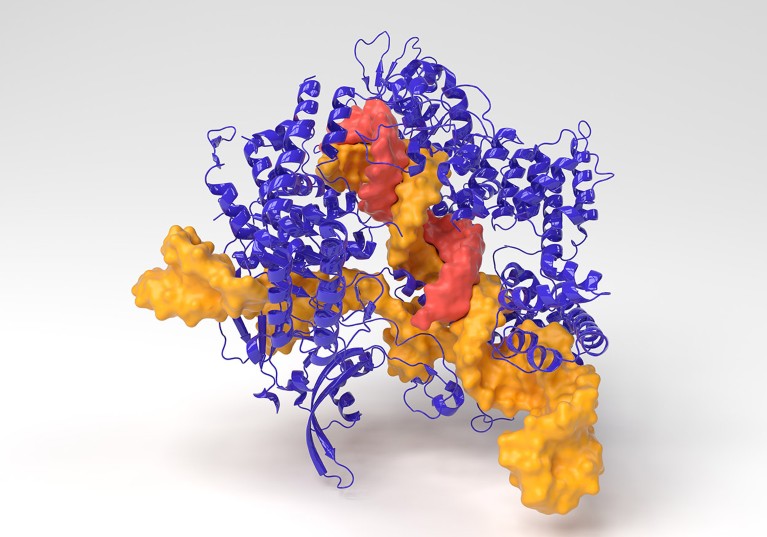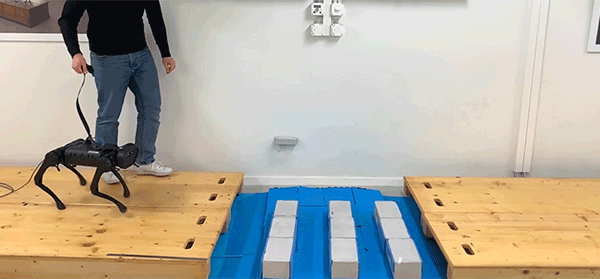Hello Nature readers, would you like to get this Briefing in your inbox free every week? Sign up here.

A 3D model of the CRISPR–Cas9 gene-editing complex from Streptococcus pyogenes.Credit: Indigo Molecular Images/Science Photo Library
‘ChatGPT’ for gene-editing tools
Researchers used a generative AI tool trained on millions of protein sequences to design CRISPR gene-editing proteins, and were then able to show that some of these systems work as expected in the laboratory. Another team developed a model trained on microbial genomes, and used it to design fresh CRISPR systems, which comprise DNA or RNA-cutting enzyme and RNA molecules that tell the molecular scissors where to cut. Natural CRISPRs — part of some microbes’ immune system — have limitations on the genes they can edit and the changes they can make. “Expanding the repertoire of editors, using AI, could help,” says synthetic biologist Alan Wong.
Reference: bioRxiv preprint 1 & preprint 2 (not peer reviewed)
Quantum computer runs transformers
Researchers adapted transformers, a deep learning design that underlies many powerful AI models, to run on a six-qubit quantum computer. The quantum transformers categorised medical images with more than 50% accuracy, about the same as classical transformers that have vastly more complex neural network architecture. The research hints at the potential of qubits, which exist in a range of quantum states, to better reflect the spectrum of real-life data than do classical computers, which are binary by nature. “Quantum computers are not expected to be a computational panacea, but we won’t know until we try,” says quantum computing researcher Christopher Ferrie.
Scientific American | 7 min read
This algorithm ranks reviewer reputation
A reputation-ranking algorithm could help journal editors find reliable peer reviewers. Solid studies are sometimes rejected because of one negative review, with little attention given to how good the reviewer is, notes environmental scientist and study co-author An Zeng. His tool scores reviewers depending on how many citations their reviewed papers have attracted. But critics highlight a number of issues with the system, including that it could bias peer review even more towards senior scientists who have reviewed particularly ground-breaking studies.
Reference: Expert Systems with Applications paper
Image of the week

Milad Shafiee et al/Nature Communications
This robot has learned to switch from trotting to pronking, to avoid slipping in between gaps in the floor. The researchers propose that avoiding falls is the main reason four-legged animals transition between gaits. Other factors, such as energy efficiency, are only secondary objectives or accidental consequences, they suggest. (Nature Communications paper | 51 min read)
Features & opinion
Why robots won’t solve the care crisis
Interactive therapeutic robots could help older people with dementia to feel less anxious and lonely — at least that’s the idea. Studies purporting the robots’ benefits often suffer from issues such as small sample sizes or improper randomization. Carers and prospective users are worried about being offered an illusion of intimacy rather than real human interaction. “Are we designing robots with and for people living with dementia? Or are we designing to manage people living with dementia?” asks ethicist Clara Berridge.
Will AI be a climate friend or foe?
Researchers urgently need to explore the future carbon footprint of AI technologies, argues a group of sustainability researchers. The direct impacts of AI computing infrastructure — currently about 0.01% of global greenhouse-gas emissions — are likely to remain relatively small, the researchers write. But there could be huge indirect impacts from the way AI tools transform our economies and societies.
Autonomous weapons are changing war
“The technical capability for a system to find a human being and kill them is much easier than to develop a self-driving car,” says computer scientist and campaigner against AI weapons Stuart Russell. Some argue that accurate autonomous weapons, such as AI-equipped drones, could reduce collateral damage while helping vulnerable nations to defend themselves. At the same time, observers are concerned that passing targeting decisions to an algorithm could lead to catastrophic mistakes.
How AI revives string theory
Machine learning is reinvigorating physicists’ quest to find out whether string theory can actually describe the universe. String theory gained popularity in the 1970s as an approach that could unite the physics of the very small and the very large. It comes down to figuring out how to ‘compact’ strings, which live in a ten-dimensional space, to represent our 4D world. AI algorithms are starting to sift through the almost endless number of ways this compactification can be done. “Does string theory make unique predictions? Is it really physics? The jury is just still out,” says physicist Lara Anderson.
